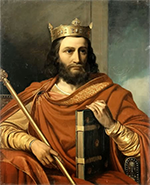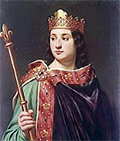Hugh the Great emerged at this point as the most powerful noble in the realm. He knew that Charles the Simple had an infant son who had been spirited away to England and had grown up in the court of the Anglo-Saxon kings Edward the Elder and Æthelstan. With the throne vacant, Hugh convinced his fellow nobles to install on it the teenage son of Charles the Simple, who became Louis IV. The new king had agreed to come back after a personal promise of loyalty from William Longsword, son of Rollo, the founder of Normandy.
Hugh the Great served as guardian of the king and effectively as regent as well. Charles named him Duke of the Franks. Louis got involved in political intrigue in both the Eastern Frankish Kingdom and Normandy. The king found himself captured in Rouen and had to ask Hugh the Great to get him out of trouble. The latter did so, restoring the former to the throne in 946. King and duke sparred off and on for another several years. King Louis IV fell seriously ill in 951 but recovered. He died three years later, from injuries sustained from a fall from his horse. His oldest son, Lothair, succeeded him on the throne.
Hugh the Great died in 956. His two sons, Hugh and Otto, received royal titles: Hugh (later known as Hugh Capet) was Duke of the Franks, and Otto was Duke of Burgundy. King Lothair IV was 13 when he became king and served for a few years under the guardianship of his uncle, Bruno, the archbishop of Cologne.

Lothair, accompanied by Hugh Capet (right), marched at the head of the army into Lorraine and sacked the imperial palace at Aachen. The response from Holy Roman Emperor Otto II was an invasion of West Francia. A rival faction of Franks then declared Lothair's younger brother, Charles, King of the Franks. Lothair and Hugh Capet returned to their homeland and drove out the invaders.
As before, king and duke had a good relationship for a time but then grew suspicious of each other. The king named his young son Louis as Junior King in 979, then sought to smooth things over with the Holy Roman Emperor, while also marrying his teenage son to Adelaide of Anjou, in order to gain control of that powerful province. Lothair set out to take more territory and further curtail Capet's power, but the king died in 983, and his son succeeded him.

Louis V (left) inherited a realm in turmoil. Two warring factions were on either side of the alliance with the Holy Roman Empire issue. Louis V tried to please both factions and ended up pleasing neither. During one more attempt at keeping the peace, he died, from a fall from his horse, in 987. He left no successor.
Louis's uncle, Charles, Duke of Lower Lorraine, was the younger brother of Louis V's father, Lothair, and considered himself to be the rightful heir to throne, through his heredity. Many nobles agreed with him.
However, even more nobles and other powerful men of France turned for their next monarch not to Charles, Duke of Lower Lorraine but Capet, who agreed to give away a large part of his father's lands in order to ensure that he could rule securely, with his son Robert as his successor. Capet had the support as well of Adalberon, the Archbishop of Reims, the most powerful clergyman in the Frankish realm.
Charles did not give up his claim to the throne lightly, and Capet's rule was punctuated by repeated battles. Capet and Charles made war on each other, and Capet finally prevailed, in part thanks to the help of another archbishop, Adalberon of Laon, who used the power of his office to trick Charles into being captured and imprisoned.
This same archbishop exchanged his loyalty for a plot against Capet in 993, but that was unsuccessful. The king held on for another three years, in 995 foiling another plot, this one to put the son of Charles, Duke of Lower Lorraine on the throne. When Capet died, in 996, his son Robert, having already been named co-ruler, had no challengers, despite the Robertians' initial reluctance to endorse hereditary succession. Capet had married Adelaide of Aquitaine in 970; they had two other children, Gisela and Hedwig.
Capet, from his power base in Paris, controlled some of what is now France but not all. His kingdom was nowhere near being the kind of comprehensive unit that the likes of Charlemagne had enjoyed two centuries earlier, but the ravages of war and factional duplicity had diminished the kings' influence through those intervening years. Still, historians refer to the descendants of Hugh Capet as the Capetian dynasty, or the House of Capet. Thus, Louis V was the last king of the Carolingian dynasty.
First page > Beginnings and Division > Page 1, 2, 3